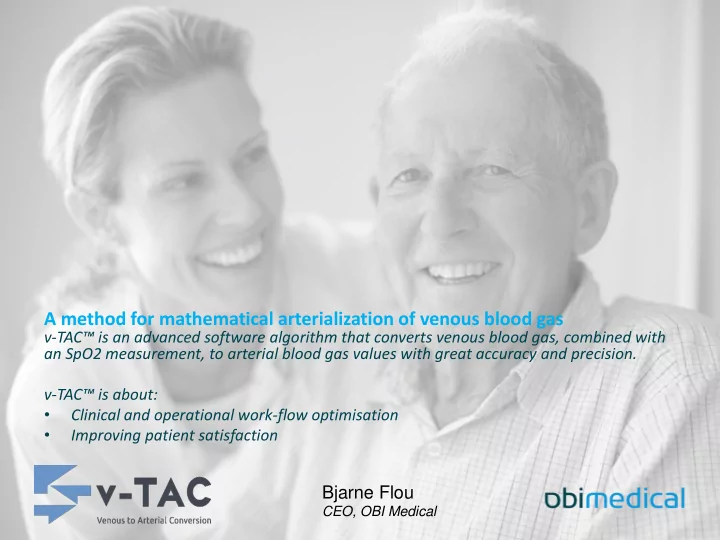

A method for mathematical arterialization of venous blood gas v- TAC™ is an advanced software algorithm that converts venous blood gas, combined with an SpO2 measurement, to arterial blood gas values with great accuracy and precision. v- TAC™ is about: • Clinical and operational work-flow optimisation • Improving patient satisfaction Bjarne Flou CEO, OBI Medical
v-TAC drives optimisation of workflow in blood gas testing With arterialisation by v-TAC, a VBG becomes a true substitute to ABG and CBG in multiple clinical applications Arterial Blood Gas (ABG) Arterial • Acid-Base & Acid-Base & Gold standard Blood gas Blood gas Venous Blood Gas (VBG) values values • Easy to get But • • Hard to get … Electrolytes, metabolics OK • Painful But • Not ideal screening tool Electrolytes Electrolytes • ABG follow-up values values Capillary Blood Gas (CBG) needed • Accepted substitute for many • Poor indicator of clinical applications • Progression of illness • Response to But treatment Metabolic Metabolic • Complex technique values values • Operator dependent Trend towards using VBG where possible 5
What is v- TAC™? v- TAC™ software algorithm Based on Siggaard-Andersen Blood Model Peripheral venous blood gas values pH pH pCO 2 pCO 2 pO 2 pO 2 * Hb - HCO 3 sO 2 BE (FMetHB) paO 2 /FiO 2 Ratio* (FCOHb) Calculated (Adults age 18+) (sO 2 ) arterial 2,3 DPG (Software application) tO 2 blood gas From tCO 2 SpO2 Pulse oximeter SBE, SBC, co-oximetry etc. available from the VBG *pO2 >10 kPa reported as ”> 10 kPa” Watch Prof. Dr. Stephen E. Rees present the principles of the v-TAC methodon our Youtube channel: https://www.youtube.com/channel/UCQT2L5zpM_VV71uQH1VT3Bw/videos 6
When can v-TAC be used? Patients age 18+ All clinical indications Can a stable NO oxygen sat (SpO2) at 75% * or above be measured? Indications of too poor circulation: • Difficulty measuring SpO2 (on the Other indications: • arm used for the sample) Peripheral is warm, red and dry; a • The arm/peripheral is cold/blue pulse can be felt YES • • Long stasis time for blood-sampling Capillary response is normal • The patient develops catecholamines (or similar) Can a peripheral NO venous sample be drawn? YES Convert using the Use alternative method, such as ABG v-TAC software 10 *Configurable, default = 80%
Typical Radiometer/v-TAC setup (Example from DK) v-TAC printer next to ABL configured for v-TAC ABL configuration: • A sample type ‘v - TAC’ is configured on the ABL to identify and mark samples for arterialisation by v- TAC™ • When ‘v - TAC’ is selected, the SpO2 value shall be entered into a mandatory input field ABL operation • In daily operation, when the venous blood sample has been taken and SpO2 measured , the ‘v - TAC’ button is selected and SpO2 entered • The v-TAC results are immediately sent to the printer (optinal) and/or sent to the LIS/EPR (optional) For additional information please request technical manual 20
v- TAC™ printed report (A4) Print from Print from v-TAC BGA v-TAC calculated arterial values Selected venous results from BGA print is transferred Printer: For example A4 to v-TAC print network laser printer (recommended) 38
v-TAC results in LIS Example from North Denmark Regional Hospital (LABKA-II) Venous Results Calculated v-TAC arterial results v-TAC results clearly marked ‘v - TAC’ according to nomenklatur defined by MEDCOM and following IUPAC standards 39
pH v- TAC™ & ABG repeatability vs ABG v- TAC™ Bias ±95% Limits of Agreement -0.001 ±0.03 v-TAC vs ABG-1 (n=416, Pooled data) v-TAC vs ABG-1 (n=416, Pooled data) ABG-2 vs ABG-1 (n=73, Toftegaard, 2008) ABG-2 vs ABG-1 (n=73, Toftegaard, 2008) Bias ± 95% Limits of agreement (v-TAC) Plots compare v-TAC pH vs ABG-1 (black dots) withToftegaard studying ABG-2 vs ABG-1 repeatability (red dots). Conclusion: v-TAC pH repeatability is comparable to arterial repeatability 44
pCO2 v- TAC™ & ABG repeatability vs ABG v- TAC™ Bias ±95% Limits of Agreement -0.043 ±0.53 kPa v-TAC vs ABG-1 (n=416, Pooled data) v-TAC vs ABG-1 (n=416, Pooled data) ABG-2 vs ABG-1 (n=73, Toftegaard, 2008) ABG-2 vs ABG-1 (n=73, Toftegaard, 2008) Bias ± 95% Limits of agreement (v-TAC) Plots compare v-TAC pCO2 vs ABG-1 (black dots) withToftegaard studying ABG-2 vs ABG-1 repeatability (red dots). Conclusion: v-TAC pCO2 repeatability is comparable to arterial repeatability 45
pO2 v- TAC™ & ABG repeatability vs ABG Plot explanation: v-TAC vs ABG-1 (n=208, Pooled data) Zoom area ABG-2 vs ABG-1 (n=192, Mallat et al., 2015) Mallat ± 95% Limits of agreement ABG-2 vs ABG-1 (n=73, Toftegaard, 2008) Toftegaard ± 95% Limits of agreement Zoom area Plots compare v-TAC pO2 vs ABG-1 (black dots) with two sources of arterial vs arterial repeatability: Mallat (green dots, studying ABG repeatability while minimizing pre-analytical and biological contributions) and Toftegaard (red dots). Conclusion: v-TAC pO2 repeatability is comparable to arterial repeatability for values of pO2 up to 10 kPa 46 Notes: • v-TAC reports calculated pO2 values between 0 to 10 kPa. If calculated pO2 exceeds 10 kPa, v- TAC reports ”pO2 > 10 kPa” • Tygesen et al. Group-B excluded due to 10-15 minutes between v-TAC and ABG
Venipuncture is easier and less paintful for the patient compared to arterial punctures Recent UK study show that: • On a scale from 0 – 10, pain associated with arterial punctures score avg 4, while venipunctures score 1 • To make 234 blood samples it takes approximately 330 arterial attempts, ~330 while the same can be done with approximately 260 venous attempts ~260 Source: McKeever et al. 2016, Using venous blood gas analysis in the assessment of COPD exacerbation: a prospekctive cohort study (REF635) 82
Thank you! More information: www.obimedical.com 94
Recommend
More recommend